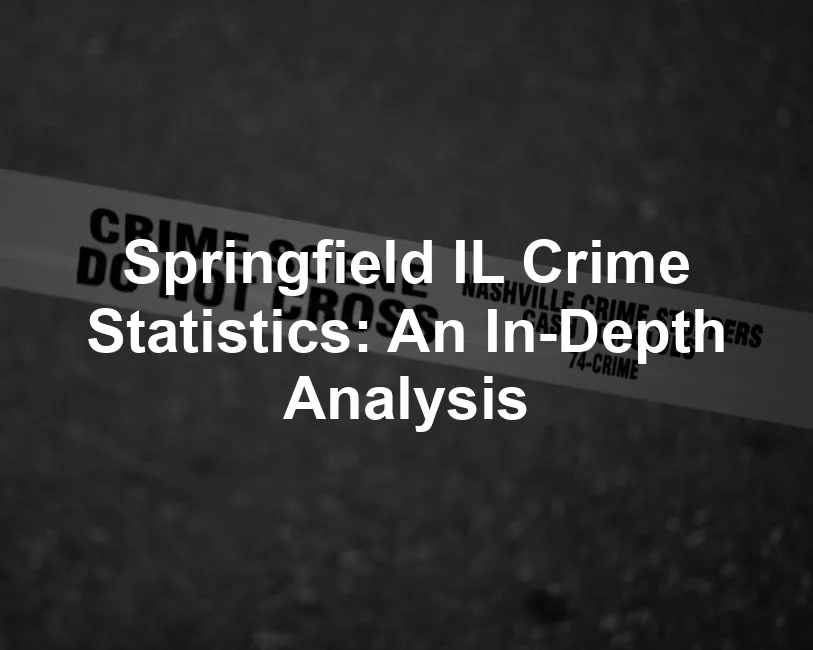Introduction
Welcome to Springfield, Illinois! This charming city is often called the “Land of Lincoln.” It’s not just the capital of Illinois; it’s also a place rich in history. From Abraham Lincoln’s home to the Lincoln Presidential Library, there’s a lot to explore. But, like any city, Springfield has its ups and downs.
Understanding crime statistics is crucial for everyone who lives here. Residents want to feel safe in their neighborhoods, while newcomers look for a place that feels secure. Policymakers, on the other hand, need accurate data to create effective strategies. After all, knowledge is power, right?
In this article, we’ll cover several key areas of interest. First, we’ll look at violent crime, which includes serious offenses like murder and robbery. Then, we’ll discuss property crime, such as burglary and theft. We’ll also analyze trends over time, which can help identify patterns. Finally, we’ll touch on community safety measures that residents can take to ensure a safer Springfield.
So, grab your detective hat! Let’s unravel the crime statistics of Springfield, IL. And if you’re looking for some thrilling reads to get into the mind of crime, check out Crime and Punishment by Fyodor Dostoevsky. It’s a classic that dives deep into the psychology of crime!
Understanding Crime Reporting in Springfield
Overview of Crime Reporting Systems
The Springfield Police Department (SPD) has adopted the National Incident-Based Reporting System (NIBRS). This system modernizes how crime data is reported. NIBRS allows for detailed information about crimes, including specifics like who committed the crime and when it happened. This advanced reporting helps the community understand crime better. It also allows the SPD to allocate resources more effectively.
Categories of Crime
Group A Offenses
Group A offenses encompass serious crimes. These include crimes against persons, property, and society. Examples are murder, robbery, and assault. Reporting both incidents and arrests for these offenses is essential. It helps the SPD keep track of crime trends and respond appropriately.
Group B Offenses
Group B offenses are typically less serious. These might include curfew violations or disorderly conduct. For these crimes, the SPD only reports arrests. This distinction is important for understanding the overall crime landscape in Springfield.
Criteria for Classifying Offenses
The SPD uses specific criteria to classify crimes. Seriousness, frequency, and public interest all play a role. If a crime is severe or happens often, it’s more likely to be classified as a Group A offense. This classification helps ensure that the most pressing issues get the necessary attention and resources from law enforcement.
In summary, understanding crime reporting in Springfield is vital for residents and community leaders alike. The NIBRS system provides a clearer picture of what’s happening in the city. With this information, everyone can work together to make Springfield a safer place to live. crime statistics springfield ma

Understanding the crime reporting system is essential for community safety. Learn more about Springfield’s crime statistics.
Current Crime Statistics
Overview of 2024 Crime Statistics
The Springfield Police Department (SPD) has published its crime statistics for 2024, and the numbers shed light on the current safety landscape in the city. The trend shows a mix of improvements and areas of concern. Monthly and year-to-date reports reveal patterns that are worth noting.
As of September 2024, the overall crime rate stands at approximately 50.46 incidents per 1,000 residents. This rate reflects a slight increase compared to the previous year, which recorded a total crime rate of 46.9 per 1,000 residents. The year-to-date statistics reveal that January to September 2024 has experienced a total of about 4,819 property crimes and 897 violent crimes.
When looking back at 2023, there was an overall increase in reported crimes. Specifically, the SPD noted a 7% rise in Group A offenses compared to 2022. This uptick included various categories, especially concerning property crimes. The proactive measures taken in reporting showed that more incidents were documented, indicating a heightened awareness in the community regarding crime.
The year-to-date comparison reveals that violent crimes have slightly decreased by 0.7% compared to the same period last year, while property crimes have surged by over 10%. The increase in property crimes, particularly motor vehicle thefts, appears to be a significant issue. This trend highlights the ongoing challenges the SPD faces in maintaining community safety. To stay prepared, consider investing in a Home Security Camera System to keep an eye on your property.

Violent Crime Breakdown
Let’s break down the violent crime statistics in Springfield. In 2024, Springfield reported 897 violent crimes. Here’s a closer look at the categories of violent crime:
| Type of Crime | Number of Crimes | Rate per 1,000 Residents |
|---|---|---|
| Murder | 7 | 0.06 |
| Rape | 99 | 0.87 |
| Robbery | 150 | 1.32 |
| Assault | 641 | 5.66 |
| Total | 897 | 7.92 |
The murder rate is relatively low, but the number of assaults is concerning. With a rate of 5.66 per 1,000 residents, the situation calls for community engagement and preventive measures. If you’re interested in understanding the psychology behind crime, I highly recommend Mindhunter: Inside the FBI’s Elite Serial Crime Unit. It offers deep insights into the minds of criminals.
Interestingly, assaults have seen a slight decrease compared to 2023, where the total was 694. While it’s a step in the right direction, the SPD emphasizes that continued community vigilance is vital for sustained improvements.

Property Crime Breakdown
Property crimes in Springfield have been on the rise. In 2024, the city reported 4,819 property crimes, with the following breakdown:
| Type of Crime | Number of Crimes | Rate per 1,000 Residents |
|---|---|---|
| Burglary | 928 | 8.19 |
| Theft | 3,379 | 29.83 |
| Motor Vehicle Theft | 512 | 4.52 |
| Total | 4,819 | 42.54 |
These figures indicate that the property crime rate in Springfield is approximately 42.54 per 1,000 residents. Notably, theft is the most prevalent property crime, with almost 3,400 incidents. This figure is significantly higher than the state average and even more so against the national average, highlighting a pressing need for community awareness and preventive strategies. If you’re interested in the forensic side of crime, check out Crime Scene Investigation: The Forensic Science of Solving Crime. It’s an eye-opener!
In comparison to Illinois, where the state average for property crimes is about 24.5 per 1,000 residents, Springfield is facing a far greater challenge. The SPD is actively working to address this issue through community programs aimed at reducing theft and burglary incidents. fremont crime statistics

Comparing crime statistics in Springfield to other areas can provide insight into safety improvements. Explore Fremont’s crime statistics for a broader perspective.
Comparative Analysis
How does Springfield stack up against its neighbors and state averages? In terms of crime rates, Springfield is among the higher tiers in Illinois. Notably, the city has a violent crime rate of 7.92 per 1,000 residents, which is higher than the state average of 4.7.
When comparing Springfield to nearby cities like Chatham and Leland Grove, the differences are stark. For instance, Leland Grove boasts a violent crime rate of just 40 per 100,000 residents, while Chatham has a rate of 49 per 100,000 residents. In contrast, Springfield’s higher rates reflect the need for enhanced safety measures.
Certain neighborhoods within Springfield also stand out. Areas like Farmingdale and Lake Pointe are often cited as safer, while other neighborhoods experience higher crime rates. This disparity emphasizes the importance of localized safety initiatives and community programs focused on crime prevention.
Understanding these statistics is essential for residents and policymakers alike. With the right information, strategies can be developed to address these challenges and create a safer Springfield for everyone. And speaking of strategies, if you’re looking for ways to protect yourself, consider Pepper Spray for Self Defense. It’s a good option for added security.

Trends Over Time
Yearly Crime Rate Trends
Crime rates in Springfield, Illinois, have fluctuated dramatically over the years. From 2010 to 2024, the city experienced shifts in both violent and property crimes. In 2010, the violent crime rate was alarmingly high, with over 1,200 incidents per 100,000 residents. Fortunately, there was a notable decrease in subsequent years. By 2022, the violent crime rate had dipped to around 437.1 per 100,000 residents, although it was still higher than the national average.
In contrast, property crime rates have shown an increasing trend. In 2023, Springfield reported a staggering 4,777 property crimes, which translated to a rate of 4,244 per 100,000 residents. This number was significantly higher than the national average, emphasizing the need for community vigilance.
Breaking it down further, 2023 saw a 7% increase in Group A offenses compared to 2022. However, violent crimes showed a slight decrease of 8.7%. Specifically, motor vehicle thefts and burglaries surged, largely driven by juvenile offenders. The SPD noted that the uptick in property crimes might reflect greater community awareness and improved reporting practices. If you’re curious about crime’s portrayal in media, consider The Devil in the White City. It’s a riveting read!

Influencing Factors
Several factors contribute to the trends observed in Springfield’s crime rates. Economic conditions play a crucial role. When the job market is weak, crime rates often rise. Springfield’s unemployment rate, for instance, stood at 3.6% in 2023, which is lower than the national average. However, economic insecurity still looms as a potential catalyst for crime.
Law enforcement changes can influence crime trends as well. The SPD’s decision to adopt the National Incident-Based Reporting System (NIBRS) has improved crime data transparency, allowing for better resource allocation and targeted community programs. The increased visibility of police efforts also affects public perception of safety.
Community programs aimed at crime prevention are essential too. Initiatives such as neighborhood watch programs foster community engagement and collaboration with law enforcement. These programs not only empower residents but also create a collective sense of responsibility for community safety. Speaking of safety, consider arming yourself with a Personal Safety Alarm Keychain. It’s a handy gadget to have!
In summary, the interplay of economic conditions, law enforcement strategies, and community engagement shapes crime trends in Springfield. Understanding these factors is vital for residents, policymakers, and law enforcement to work together toward a safer community.

Community Safety and Crime Prevention
Community Perspectives
Residents’ feelings of safety in Springfield vary widely. A survey revealed that while 28% of participants felt very safe, a significant 72% expressed concerns about safety, particularly at night. This mixed sentiment highlights the need for ongoing community dialogue and action around crime prevention.
Local law enforcement, particularly the Springfield Police Department (SPD), has taken active steps to improve community relations. Initiatives include outreach programs and community meetings designed to foster trust and cooperation between police and residents. The SPD is committed to ensuring that all community members feel heard and valued.
Moreover, the SPD’s visibility in neighborhoods has increased, resulting in enhanced community engagement. The presence of officers at local events and town hall meetings allows residents to voice their concerns and suggestions directly to law enforcement.

Crime Prevention Strategies
Various strategies have been implemented to bolster community safety. One effective approach is the establishment of neighborhood watch programs. These initiatives empower residents to look out for one another and report suspicious activities to the police. Such programs have proven successful in reducing crime rates in many communities.
Additionally, the SPD collaborates with local organizations to provide educational resources on crime prevention. Workshops on topics like home security and personal safety equip residents with practical tools to protect themselves and their property. For example, a Tactical Flashlight can be a great addition to your safety toolkit.
Community engagement plays a vital role in crime prevention. By fostering connections among residents, Springfield can create a supportive environment where people feel safe and secure. The SPD encourages continuous dialogue with the community to adapt strategies based on evolving needs.
Through these collaborative efforts, Springfield aims to enhance community safety and build a resilient neighborhood. As residents and law enforcement work together, the city moves closer to achieving a safer Springfield for all. And if you’re interested in more insights on crime literature, check out The Innocent Man by John Grisham. It’s a gripping exploration of justice.

FAQs
What is the crime rate in Springfield, IL?
Springfield, IL, has a crime rate of 50.46 incidents per 1,000 residents. This figure is notably higher than the national average. In comparison, your chances of becoming a victim of a crime here are about one in 20. The violent crime rate stands at 7.92 per 1,000 residents, which includes offenses such as murder, rape, robbery, and assault. While the murder rate is relatively low, assaults remain a pressing concern. Overall, Springfield’s crime statistics highlight the need for community vigilance and proactive safety measures.
How does Springfield compare to other cities in Illinois?
When stacked against other cities in Illinois, Springfield’s crime rates are concerning. For instance, the violent crime rate in Springfield is significantly higher than the state average of 4.7 per 1,000 residents. Cities like Leland Grove boast a much lower violent crime rate, clocking in at just 40 per 100,000 residents. Meanwhile, Chatham’s rate is around 49 per 100,000. This stark contrast emphasizes the need for targeted safety initiatives in Springfield.
What are the safest neighborhoods in Springfield?
Not all neighborhoods in Springfield are created equal when it comes to safety. Some of the safest areas include Farmingdale, Lake Pointe, and Curran. These neighborhoods boast lower crime rates and often have active community safety initiatives. Residents of these neighborhoods participate in neighborhood watch programs and collaborate with local law enforcement, which fosters a strong sense of community safety. Such efforts help to create a welcoming environment for families and individuals alike.
How can residents contribute to crime prevention?
Residents play a crucial role in crime prevention. Here are some practical tips to enhance safety in your neighborhood: 1. Stay Informed: Keep up with local crime statistics and safety alerts. 2. Join a Neighborhood Watch: Collaborate with neighbors to monitor suspicious activities. 3. Report Suspicious Activity: Don’t hesitate to contact law enforcement if you notice anything unusual. 4. Secure Your Home: Use proper locks, security cameras, and outdoor lighting to deter crime. 5. Engage with Community Programs: Participate in local safety initiatives and events to foster a safer environment. By taking these steps, residents can significantly contribute to making Springfield a safer place.
Where can I find more detailed crime statistics?
For those seeking in-depth crime statistics, the Springfield Police Department (SPD) provides a wealth of information. You can view their crime reports and monthly updates on their official website here. Additionally, resources like NeighborhoodScout offer detailed crime analytics, comparisons, and trends for Springfield and surrounding areas. These resources are invaluable for anyone wanting to stay informed about local crime dynamics.
Please let us know what you think about our content by leaving a comment down below!
Thank you for reading till here 🙂
All images from Pexels




